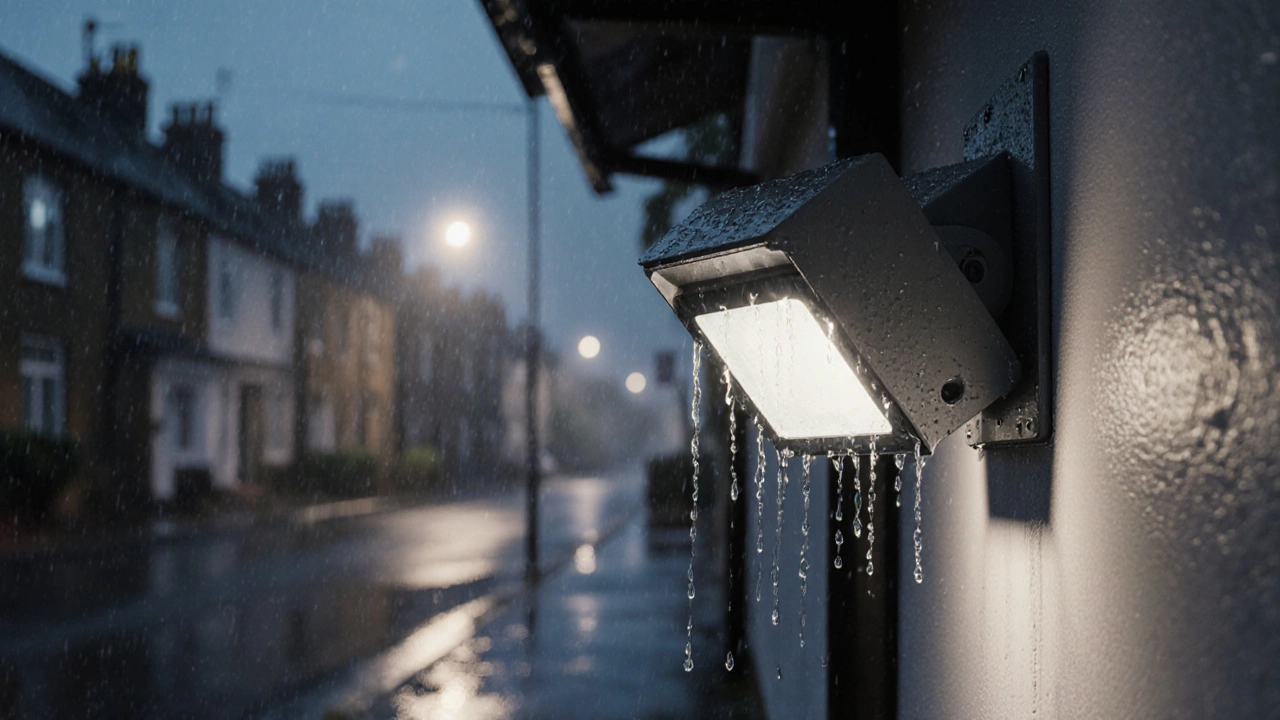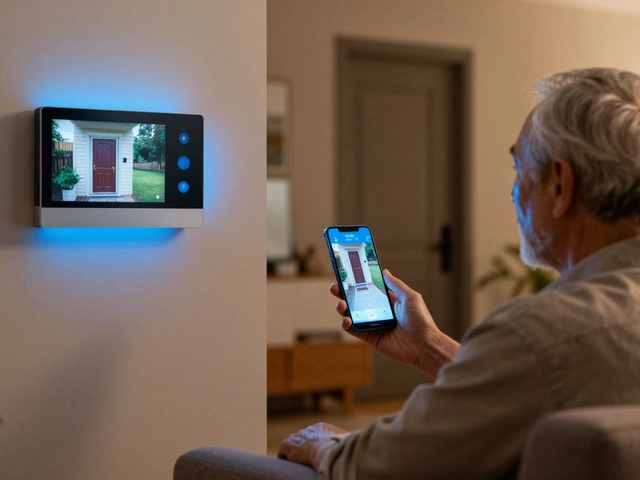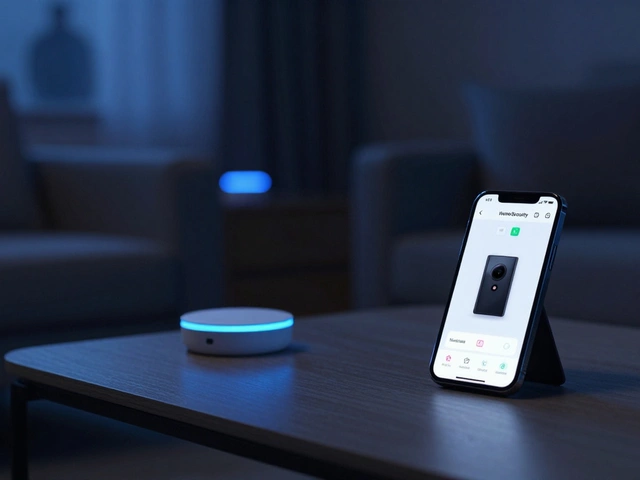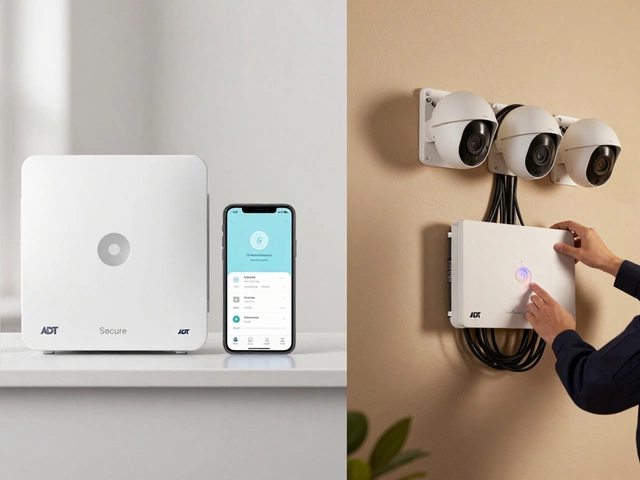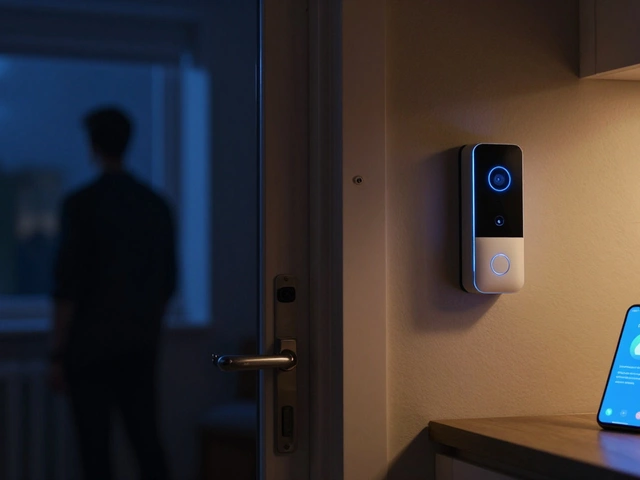Outdoor Security Light IP Rating Calculator
Security Light IP Rating Calculator
IP Rating Guide
- IP65 Water Jets
- IP66 Heavy Rain
- IP67 Submersion
- IP68 Continuous Submersion
Why outdoor security lights fail in the rain
Outdoor security lights don’t just get dimmer when it rains-they can short out, spark, or even start a fire. Water doesn’t just sit on the surface; it seeps into tiny gaps around wires, connectors, and seals. Once inside, it causes corrosion, rusts metal parts, and creates pathways for electricity to escape where it shouldn’t. In the UK, where rain is frequent and humidity stays high, this isn’t just a nuisance-it’s a safety risk. According to field tests by Stack Heating, over 72% of outdoor lighting failures are caused by water damage. And it’s not just the light that’s at risk. Moisture near electrical connections can carry as little as 50 volts of current, enough to give someone a dangerous shock.
What IP ratings actually mean for your lights
Not all outdoor lights are built the same. The key to knowing if a light can handle rain is its IP rating-the Ingress Protection code defined by the International Electrotechnical Commission. This isn’t marketing jargon. It’s a real, tested standard.
Look for these ratings on your security light packaging:
- IP65: Protects against water jets from any direction. Good for wall-mounted lights under eaves.
- IP66: Handles heavy rain and powerful spray. Best for open yard lights or areas with wind-driven rain.
- IP67: Can survive being submerged in 1 meter of water for 30 minutes. Ideal for ground-level fixtures or near patios.
- IP68: Designed for continuous submersion. Required for pool lights or flood-prone areas.
Anything below IP65 is not safe for outdoor use. Even if the box says "weather-resistant," if it doesn’t list an IP65 or higher rating, walk away. UL Solutions reports that 83% of new safety certifications now require at least IP65-up from just 56% in 2015. That’s not a trend. It’s a standard.
Choosing the right materials for long-term protection
It’s not just about the rating. The materials matter just as much. A light with an IP68 rating made from cheap plastic will still fail within a year in coastal areas like Bristol, where salt air eats through metal and UV rays break down plastics.
Look for these specific materials:
- Marine-grade aluminum (6061-T6): Resists corrosion even in salty, humid air. Lasts 15+ years. Standard aluminum? It rusts in 3 to 5 years.
- UV-stabilized polycarbonate: Keeps its strength after 10,000 hours of direct sun. Regular plastic yellows, cracks, and becomes brittle after just 5,000 hours.
- Stainless steel or brass hardware: Avoid zinc-plated screws-they rust fast. Look for stainless steel screws and clips.
Parc Lighting’s testing showed that fixtures using these materials lasted over 8 years with no signs of degradation. Cheaper ones? Half failed before year 4.
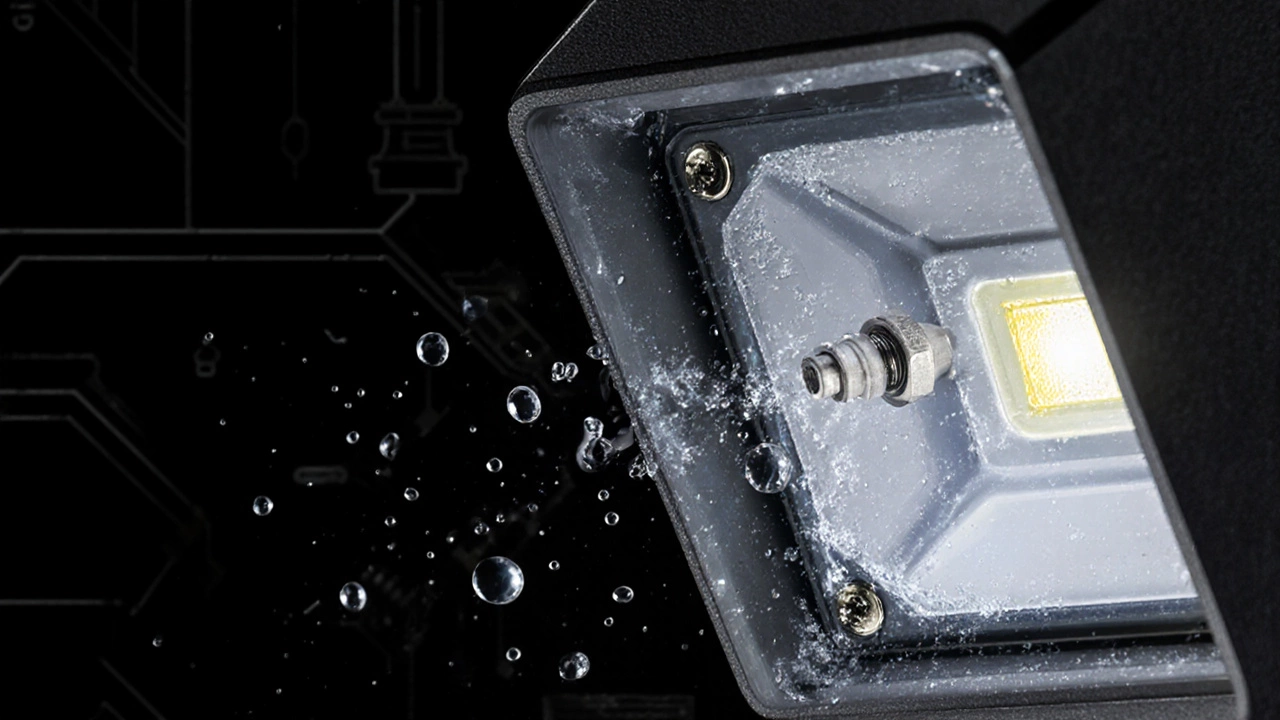
How to install outdoor security lights so they stay dry
Even the best-rated light will leak if it’s installed wrong. Here’s what actually works:
- Position the light with drainage holes facing down. Water should flow out, not pool inside. Tilt the fixture 15 degrees downward if possible.
- Keep vegetation at least 50mm away. Leaves and vines trap moisture against the housing, creating a mini rainforest around your light.
- Use IP68-rated connectors. The weakest point in any system is where wires meet. Use Wago 221 connectors with dielectric grease (like MG Chemicals 8101) to seal connections. This stops corrosion before it starts.
- Don’t seal the bottom. If your fixture has a drain hole, leave it open. Sealing it traps moisture inside and makes corrosion worse.
- Leave expansion space. Temperature changes make materials expand and contract. Leave 10-15% extra room in mounting channels to prevent cracking.
Stack Heating’s electrical safety audit found that 68% of DIY installations created new hazards-like moisture trapped inside sealed boxes. That’s worse than no protection at all.
DIY waterproofing: What works and what doesn’t
Some people try to save money by spraying their lights with waterproofing spray or wrapping them in plastic. Here’s what happens:
- Waterproofing spray: Boosts a basic IP20 light to IPX4. Sounds good? It lasts 12 to 18 months-then cracks and peels. Bernardi Lighting’s tests show these sprays fail completely after 2 years.
- Silicone sleeves: Used on LED strips, they offer IP67 protection but cut brightness by 30-40%. Not ideal for security lights where visibility matters.
- Aluminum channels with polycarbonate covers: These are the gold standard. They maintain 90-95% brightness and last 7+ years. They cost more upfront, but they’re the only DIY method that doesn’t need constant reapplication.
Wired4Signs USA’s 2024 Aluminum Channel Pro series includes built-in drainage channels that reduce internal moisture by 92%. If you’re installing LED strips, this is the only reliable way to do it yourself.
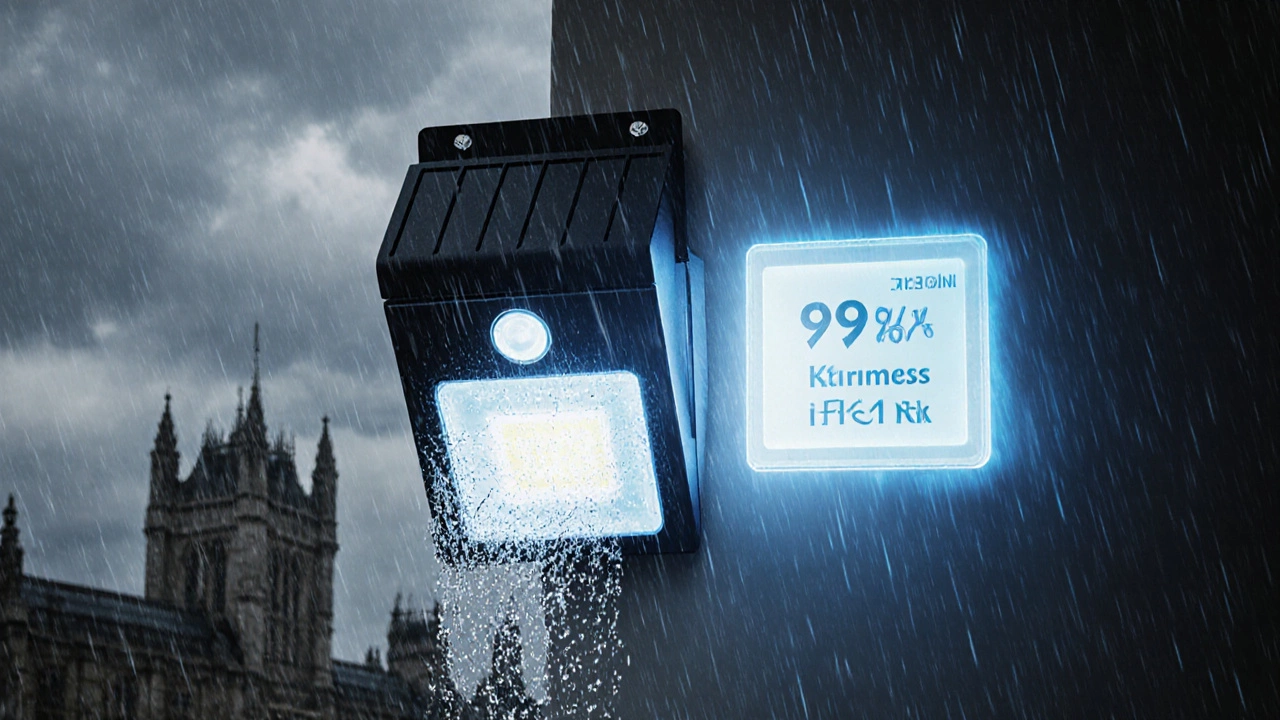
Why professional installation is worth the cost
Yes, a professionally installed IP68 system costs 30-50% more than a DIY job. But here’s the real math:
- DIY lights: Last 2-3 years. Replace every 2 years. Total cost over 10 years: $300+
- Professional IP68 system: Lasts 8-10 years. One-time cost: $400.
Parc Lighting’s analysis of 500 homes found that professional installations reduced maintenance costs by 75% over 10 years. That’s not just money saved-it’s peace of mind. And if your light fails at night, your security system is useless.
Plus, improper DIY work is a fire hazard. Stack Heating’s data shows 23% of outdoor lighting fires came from bad waterproofing. Insurance companies are starting to notice. Some now deny claims if they find non-compliant outdoor lighting.
What’s coming next in outdoor lighting protection
Technology is moving fast. By late 2025, you’ll start seeing lights with:
- Self-healing hydrophobic coatings: Scratch the surface? The coating repairs itself and repels water again.
- Integrated moisture sensors: If humidity hits 85%, the light shuts off automatically to prevent electrical damage.
- Nano-coatings: In testing now, these offer IP69K protection (resisting high-pressure steam cleaning) while keeping 98% of the light output.
By 2027, 95% of new outdoor lights will have built-in waterproofing. The question isn’t whether you’ll need it-it’s whether you’re ready for the upgrade.
Final checklist: Are your outdoor security lights rain-ready?
- ✅ Has the light an IP65 rating or higher?
- ✅ Is it made from marine-grade aluminum or UV-stabilized polycarbonate?
- ✅ Are all wire connections sealed with IP68-rated connectors and dielectric grease?
- ✅ Is the fixture mounted with drainage holes facing down and clear of plants?
- ✅ Is there no silicone or tape sealing the bottom of the housing?
- ✅ Have you replaced any spray-on waterproofing in the last 18 months?
If you answered no to any of these, your lights are at risk. Don’t wait for a storm to find out.
Can I use regular indoor lights outdoors if I cover them with a plastic box?
No. Indoor lights aren’t built to handle moisture, temperature swings, or UV exposure. Even if you put them in a box, water will still get in through wire entry points. The seals aren’t designed for outdoor use, and condensation will build up inside the box. This creates a perfect environment for corrosion and electrical shorts. Always use lights rated for outdoor use with at least an IP65 rating.
Do solar-powered outdoor security lights need waterproofing too?
Yes, absolutely. Solar lights often have the same vulnerabilities as wired ones-especially at the battery compartment and charging port. Many cheap solar lights use plastic casings that crack in cold weather, letting water in. Look for solar lights with IP65 or higher ratings, sealed battery compartments, and UV-resistant materials. The solar panel itself should also be made of tempered glass, not regular plastic.
Is it safe to clean outdoor security lights with a pressure washer?
Only if the light has an IP67 or higher rating. Pressure washers can deliver water at over 1,000 PSI-far beyond what IP65 can handle. Even a small crack or worn seal can let water in under pressure. For cleaning, use a soft brush, mild soap, and a hose on low pressure. Never point the nozzle directly at seams or connectors.
Why do my outdoor lights keep flickering after it rains?
Flickering after rain means water is getting into the wiring or connections. This causes intermittent contact, which disrupts the power flow. It’s a sign of failing seals, corroded connectors, or a cracked housing. Don’t ignore it. This is a fire risk. Turn off the power and inspect the fixture. Replace any damaged parts or upgrade to a higher IP-rated model.
What’s the best time of year to install or replace outdoor security lights?
Late spring or early autumn is ideal. Avoid winter (too cold for sealants to cure) and summer (high humidity slows drying). Choose a dry day with temperatures between 15°C and 25°C. This gives silicone sealants and dielectric grease time to bond properly before rain returns. Always let products cure for 24 hours before turning the lights on.

